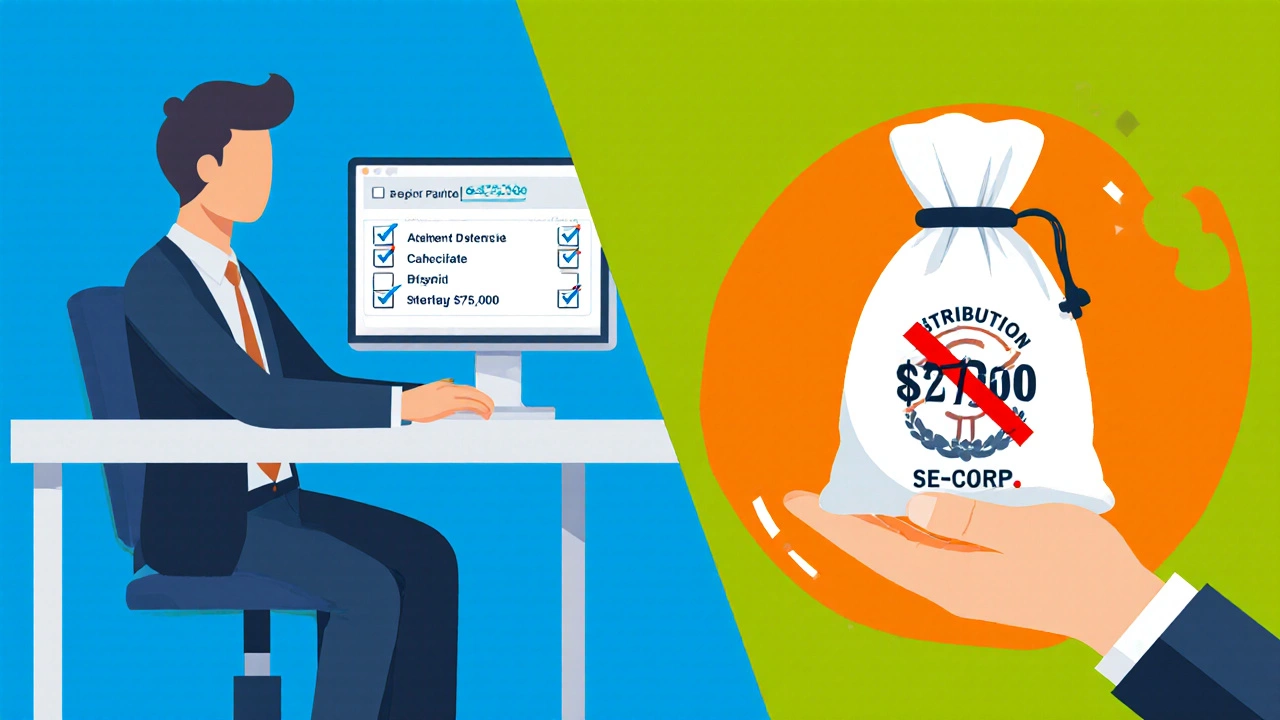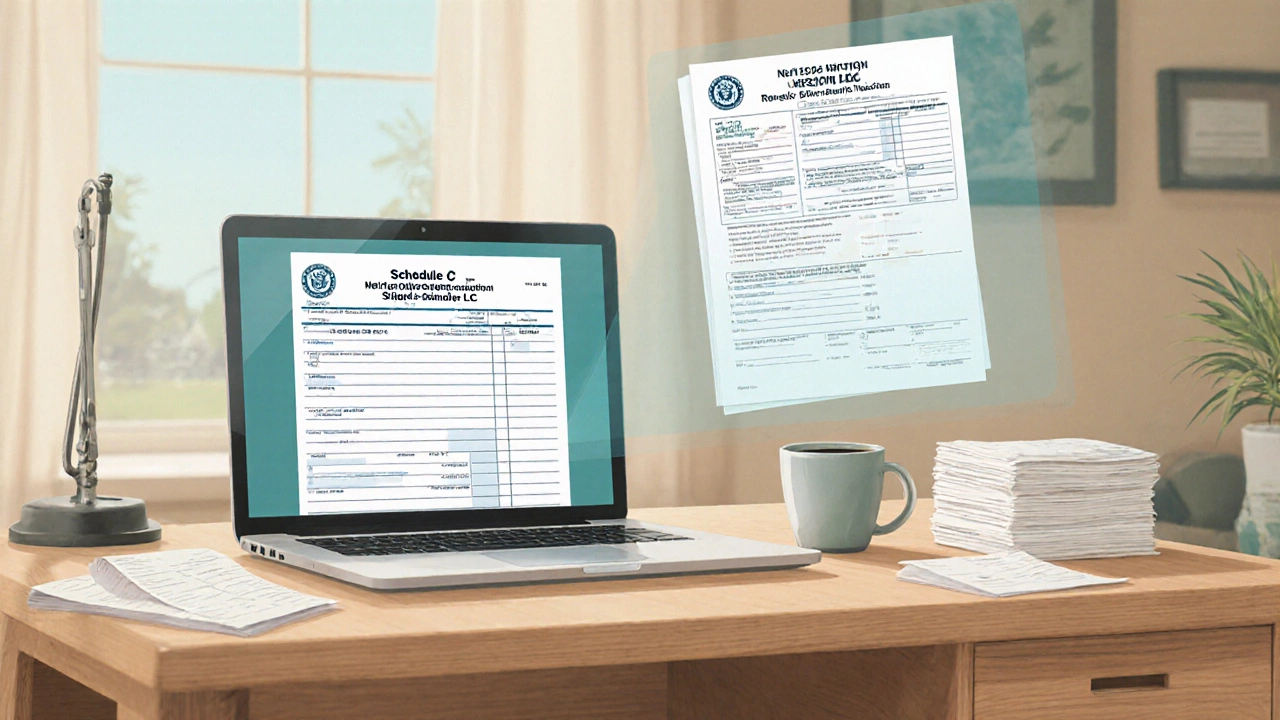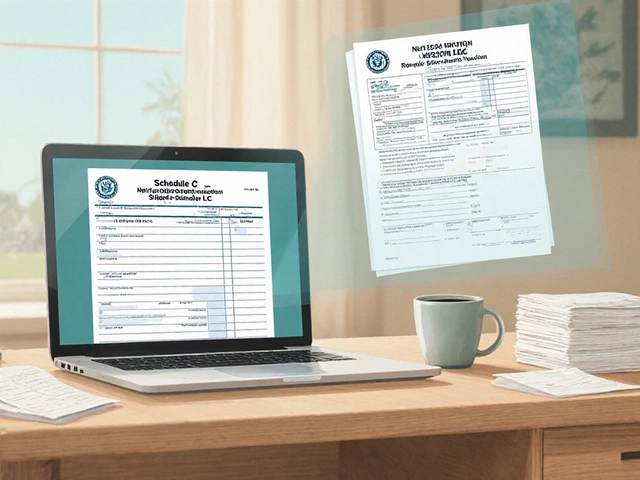LLC Self-Employment Tax Calculator
Enter your information and click "Calculate Tax Savings" to see potential savings.
This calculator shows how electing S-Corp status can reduce your self-employment tax burden:
- Without S-Corp election: All net income is subject to 15.3% SE tax
- With S-Corp election: Only the salary portion is subject to SE tax
- Additional savings from retirement contributions and deductions
Typical savings range from 5% to 10% of gross income when properly implemented.
Quick Takeaways
- LLCs are usually subject to self‑employment tax on net earnings.
- Electing to be taxed as an S corporation can split income into salary (subject to payroll tax) and distributions (not subject to SE tax).
- Pay yourself a "reasonable" salary, run payroll correctly, and claim the Qualified Business Income deduction.
- Hiring family members, setting up a retirement plan, and tracking business expenses further lower taxable earnings.
- Follow a step‑by‑step checklist to implement each strategy and stay IRS‑compliant.
What Is Self‑Employment Tax?
Self‑employment tax (SE tax) covers Social Security and Medicare contributions for individuals who work for themselves. For 2025 the rate is 15.3% on the first $160,200 of net earnings (12.4% Social Security + 2.9% Medicare) plus an additional 0.9% Medicare surtax on higher incomes.
When you operate an LLC a limited liability company that provides legal protection for its owners while allowing flexible tax treatment, the default tax classification depends on the number of members:
- Single‑member LLC → taxed as a sole proprietorship (Schedule C), net earnings are subject to SE tax.
- Multi‑member LLC → taxed as a partnership (Form 1065), each member's distributive share is subject to SE tax.
Because the IRS treats the net profit as earned income, you end up paying the 15.3% SE tax on top of regular income tax.
Why an LLC Pays More Tax Than a Corporation
Corporations (C‑corp or S‑corp) pay payroll taxes only on the wages they issue to employees. Any profit left as a dividend or distribution isn’t subject to SE tax. That distinction is the key to reducing the tax burden.

Primary Strategies to Reduce or Avoid SE Tax
Below are the most effective tactics used by small‑business owners.
1. Elect S‑Corporation Tax Status
By filing Form 2553, an LLC can elect to be taxed as an S corporation a pass‑through entity where income is reported on the owners' personal returns, but only wages are subject to employment taxes. This splits income into two buckets:
- Reasonable salary - subject to payroll taxes (Social Security, Medicare).
- Distributions - not subject to SE tax, only income tax.
Most owners see a 5%‑10% overall tax reduction after accounting for payroll processing costs.
2. Pay Yourself a Reasonable Salary
The IRS expects S‑corp owners to receive compensation that reflects the market value of the work performed. Underpaying can trigger an audit and re‑classification of distributions as wages.
Use industry salary surveys, your business’s revenue, and the time you spend on operations to set a figure. For a service‑based LLC earning $150k net, a salary of $70k-$90k is often considered reasonable.
3. Run Payroll Properly
Once you decide on a salary, you must run payroll each pay period, with withholdings for federal and state income tax, Social Security, Medicare, and applicable unemployment taxes. Outsourcing to a payroll service (e.g., Gusto, QuickBooks Payroll) reduces error risk.
4. Claim the Qualified Business Income (QBI) Deduction
Section 199A allows up to a 20% deduction on qualified business income for pass‑through entities, including S‑corps. The deduction reduces taxable income, indirectly lowering the total tax owed.
Be aware of phase‑outs for high earners (>$165,000 for single filers, $330,000 for joint). If you’re below the threshold, you can fully benefit.
5. Hire Family Members
Paying a spouse or children for legitimate work can shift income to lower‑tax brackets. Children under 18 are exempt from the employer portion of Social Security and Medicare taxes when employed by a parent’s LLC.
Make sure the work is real, documented, and paid at a market rate to avoid scrutiny.
6. Set Up a Retirement Plan
Contributing to a SEP‑IRA, Solo 401(k), or SIMPLE IRA reduces current taxable income. Since contributions are made pre‑tax, they lower the net earnings subject to SE tax as well.
For 2025, a Solo 401(k) allows employee deferrals up to $22,500 (plus $7,500 catch‑up if 50+) and employer contributions up to 25% of compensation.
7. Track and Maximize Business Deductions
Every legitimate expense-office rent, equipment, software subscriptions, travel-lowers net profit, which directly reduces SE tax. Keep detailed receipts and use accounting software to capture categories accurately.
Step‑by‑Step Guide to Elect S‑Corporation Status
- Confirm Eligibility:
- LLC must be domestic.
- All shareholders must be U.S. citizens/residents.
- Only one class of stock allowed.
- Choose a Tax Year: Most LLCs use calendar year, which works for S‑corp election.
- File Form 2553:
- Complete Part I - election and shareholder signatures.
- Attach a statement of the effective date (usually the start of the next tax year).
- Mail to the IRS Service Center or file electronically if using tax software.
- Set Up Payroll:
- Register for an EIN (if not already).
- Enroll in a payroll service or software.
- Determine pay periods (bi‑weekly is common).
- Determine Reasonable Salary:
- Research industry compensation via Bureau of Labor Statistics or salary.com.
- Document the calculation method in your corporate minutes.
- Pay Salary and Distribute Profits:
- Run payroll each period, withhold taxes, and remit to the IRS/ state.
- At year‑end, issue a Schedule K‑1 for each shareholder’s share of profit.
- File Annual Returns:
- Form 1120‑S - U.S. Income Tax Return for an S Corporation.
- Attach Schedule K‑1 to each shareholder’s Form 1040.
Remember: the election must be filed no later than two months and 15 days after the start of the tax year you want it to apply.
Comparison Table: Tax Treatment Options for an LLC
| Classification | Tax Form | SE Tax on Net Income | Payroll Required? | Key Benefit |
|---|---|---|---|---|
| Single‑Member (default) | Schedule C (Form 1040) | Yes - 15.3% on all net earnings | No | Simple filing, no corporate formalities |
| Multi‑Member (default) | Form 1065 + Schedule K‑1 | Yes - each member pays SE tax on share | No | Pass‑through taxation, shared liability |
| S‑Corp Election | Form 1120‑S + Schedule K‑1 | Only on reasonable salary (not on distributions) | Yes - run payroll for salary portion | Potential 5‑10% overall tax savings |

Checklist: Avoiding SE Tax for Your LLC
- ✔︎ Determine if your LLC qualifies for S‑corp election.
- ✔︎ File Form 2553 before the deadline.
- ✔︎ Research industry salary levels and set a reasonable wage.
- ✔︎ Implement a reliable payroll system.
- ✔︎ Document salary calculations in board minutes.
- ✔︎ Separate personal and business expenses; track every deductible cost.
- ✔︎ Consider hiring eligible family members for legitimate tasks.
- ✔︎ Open a retirement plan (SEP‑IRA, Solo 401(k)) and make contributions.
- ✔︎ Claim the QBI deduction on your personal return.
- ✔︎ Review quarterly tax estimates to avoid underpayment penalties.
Frequently Asked Questions
Can a single‑member LLC elect S‑corp status?
Yes. Even a one‑person LLC can file Form 2553 and be taxed as an S‑corp, provided the owner is a U.S. citizen or resident and the LLC meets the eligibility rules.
What happens if the IRS deems my salary "unreasonable"?
The IRS may reclassify part of the distributions as wages, making those amounts subject to payroll taxes and potentially assessing penalties. Keeping documentation of salary studies and board minutes helps defend your position.
Do I still need to pay self‑employment tax on the salary I receive?
The salary is subject to the standard employee portion of Social Security and Medicare (6.2% + 1.45%). Your employer (the LLC) pays the matching amount, so the total is the same 15.3% but split between employee and employer.
Can I still claim the QBI deduction after electing S‑corp?
Absolutely. The QBI deduction applies to qualified business income from pass‑through entities, including S‑corps, subject to the income limits and other restrictions.
Is it worth the extra paperwork to run payroll?
For most LLCs earning over $100k net, the tax savings from avoiding SE tax on distributions outweigh the modest cost of payroll services (often $20‑$50 per month). The key is to keep the salary reasonable and consistent.
Next Steps Depending on Your Situation
If you’re just starting out and earn under $50k net. Stick with the default sole‑proprietor treatment, focus on maximizing deductions, and revisit S‑corp election next year when profits grow.
If you’ve already crossed $100k net profit. Run the eligibility checklist, file Form 2553, set a market‑rate salary, and use a payroll service. Expect noticeable tax relief by year‑end.
If you employ family members. Draft clear job descriptions, keep time‑sheets, and pay at least the federal minimum wage for the duties performed. This tucks income into a lower bracket without triggering extra SE tax.
If you want to invest for retirement. Open a Solo 401(k) or SEP‑IRA today, contribute the maximum allowed, and enjoy the dual benefit of reduced taxable income and future retirement savings.
In every case, keep organized records, consult a tax professional for your specific numbers, and stay on top of quarterly estimated payments. With the right structure, an LLC can keep more of its earnings and stay clear of unnecessary self‑employment tax.


